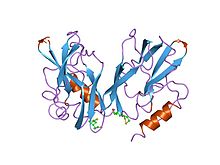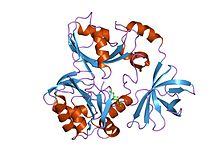Glycine synthase
| Glycine cleavage H-protein | |||||||||
|---|---|---|---|---|---|---|---|---|---|

refined structures at 2 angstroms and 2.2 angstroms of the two forms of the h-protein, a lipoamide-containing protein of the glycine decarboxylase
|
|||||||||
| Identifiers | |||||||||
| Symbol | GCV_H | ||||||||
| Pfam | PF01597 | ||||||||
| Pfam clan | CL0105 | ||||||||
| InterPro | IPR002930 | ||||||||
| SCOP | 1htp | ||||||||
| SUPERFAMILY | 1htp | ||||||||
|
|||||||||
| Available protein structures: | |
|---|---|
| Pfam | structures |
| PDB | RCSB PDB; PDBe; PDBj |
| PDBsum | structure summary |
| Glycine cleavage T-protein, Aminomethyltransferase folate-binding domain | |||||||||
|---|---|---|---|---|---|---|---|---|---|

crystal structure of a component of glycine cleavage system: t-protein from pyrococcus horikoshii ot3 at 1.5 a resolution
|
|||||||||
| Identifiers | |||||||||
| Symbol | GCV_T | ||||||||
| Pfam | PF01571 | ||||||||
| Pfam clan | CL0289 | ||||||||
| InterPro | IPR006222 | ||||||||
| SCOP | 1pj5 | ||||||||
| SUPERFAMILY | 1pj5 | ||||||||
|
|||||||||
| Available protein structures: | |
|---|---|
| Pfam | structures |
| PDB | RCSB PDB; PDBe; PDBj |
| PDBsum | structure summary |
| Glycine cleavage T-protein C-terminal barrel domain | |||||||||
|---|---|---|---|---|---|---|---|---|---|

crystal structure of t-protein of the glycine cleavage system
|
|||||||||
| Identifiers | |||||||||
| Symbol | GCV_T_C | ||||||||
| Pfam | PF08669 | ||||||||
| InterPro | IPR013977 | ||||||||
| SCOP | 1pj5 | ||||||||
| SUPERFAMILY | 1pj5 | ||||||||
|
|||||||||
| Available protein structures: | |
|---|---|
| Pfam | structures |
| PDB | RCSB PDB; PDBe; PDBj |
| PDBsum | structure summary |
The glycine cleavage system (GCS) is also known as the glycine decarboxylase complex or GDC. The system is a series of enzymes that are triggered in response to high concentrations of the amino acid glycine. The same set of enzymes is sometimes referred to as glycine synthase when it runs in the reverse direction to form glycine. The glycine cleavage system is composed of four proteins: the T-protein, P-protein, L-protein, and H-protein. They do not form a stable complex, so it is more appropriate to call it a "system" instead of a "complex". The H-protein is responsible for interacting with the three other proteins and acts as a shuttle for some of the intermediate products in glycine decarboxylation. In both animals and plants the glycine cleavage system is loosely attached to the inner membrane of the mitochondria. Mutations in this enzymatic system are linked with glycine encephalopathy.
In plants, animals and bacteria the glycine cleavage system catalyzes the following reversible reaction:
In the enzymatic reaction, H-protein activates the P-protein, which catalyzes the decarboxylation of glycine and attaches the intermediate molecule to the H-protein to be shuttled to the T-protein. The H-protein forms a complex with the T-protein that uses tetrahydrofolate and yields ammonia and 5,10-methylenetetrahydrofolate. After interaction with the T-protein, the H-protein is left with two fully reduced thiol groups in the lipoate group. The glycine protein system is regenerated when the H-protein is oxidized to regenerate the disulfide bond in the active site by interaction with the L-protein, which reduces NAD+ to NADH and H+.
When coupled to serine hydroxymethyltransferase, the glycine cleavage system overall reaction becomes:
In humans and most vertebrates, the glycine cleavage system is part of the most prominent glycine and serine catabolism pathway. This is due in large part to the formation 5,10-methylenetetrahydrofolate, which is one of the few C1 donors in biosynthesis. In this case the methyl group derived from the catabolism of glycine can be transferred to other key molecules such as purines and methionine.
...
Wikipedia
